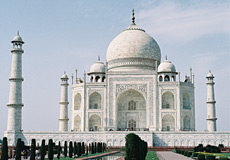 |
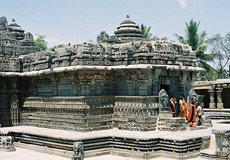 |
| Physicists visiting India for an International Linear Collider meeting enjoyed seeing historical landmarks. |
| Photos: Gregory Loew |
Indias drive for science
Particle accelerator research is a key element in Indias vision of nation-building.
by David Harris
with additional reporting by Monica Bobra and Mike Perricone
The lush 1740-acre grounds with an artificial lake, tropical foliage, sporting facilities, and small hospital do not immediately bring to mind a physics laboratory. But this community in Indore, India, is home to 1200 people from across India, most of whom live and work on site in the recently rededicated Raja Ramanna Centre for Advanced Technology (RRCAT). Apart from the pleasant scenery and the fact that the lab functions in Hindi and English, two of the sixteen languages recognized by the Indian government, RRCAT appears to be a smaller-scale version of a US particle physics lab.
The Indian Department of Atomic Energy founded the lab, then called the Centre for Advanced Technology, as India's entry in laser and accelerator physics in 1979. Now, the lab's facilities are internationally competitive, including a newly upgraded synchrotron light source called Indus-II, and its products are benefiting India's society. And what could pass as a quiet, small town is a critical element in a science-and-technology revolution that is transforming this massive country, home to more than a billion people.
Leaders revere science
The president of India, Dr. A.P.J Abdul Kalam, has been a driving force behind the country's recent emphasis on science. An aeronautical engineer by training, he had a lengthy, distinguished career as scientist and science policy advisor before becoming a politician.
Speaking on May 11, 2006, India's Technology Day, Kalam said, "This day reminds us: our constant strive to achieve self reliance in critical technologies, to encourage innovations and to nurture technology flow to industry for product excellence, so that our nation has the competitive edge leading to our cherished vision of developed India."
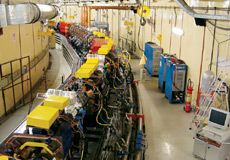 |
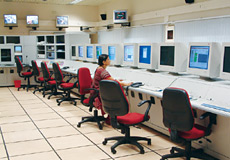 |
| The Raja Ramanna Centre for Advanced Technology has recently commissioned its upgraded Indus-II X-ray light source. |
| Photos: Monica Bobra |
The appreciation for science and technology as a driver of national development is rooted in the early years following India's independence in 1947. Visiting the RRCAT lab and the Indus-II synchrotron, Prime Minister Manmohan Singh recently recalled the guiding words of India's first Prime Minister, Jawaharlal Nehru: "Scientific institutions are the temples of modern India, and play a key role in the gigantic task of national development and nation building."
The director of RRCAT, Vinod Sahni, says success generates credibility. "Starting from scratch to accomplishing what we managed to accomplish gives us a certain respect," he explains. "When you start from scratch, policymakers have some hesitation. They're concerned about undertaking a big project with a weak infrastructure. The gradient at which we have been able to grow, despite our constraints, means we must have an innate capability."
Collaboration issues
RRCAT has fueled much of India's current particle physics revolution, along with India's collaborations at Fermilab in the United States and CERN in Europe. The Center for Advanced Technology led the LHC collaboration effort by building magnets. CAT outbid others for a US$25 million collaboration with CERN—and delivered the magnets ahead of schedule. The high quality of the magnets led to Indian industry taking over some contracts that had initially been awarded to others. The growing likelihood of increased involvement with R&D for the proposed International Linear Collider (ILC) will fuel the revolution even further.
Collaborating will help quicken the pace of India's scientific development, but there remain challenges in forming effective collaborations. Vinod Bharadwaj, of Stanford Linear Accelerator Center (SLAC), points to some of the issues. "It is very difficult to get [collaboration] moving," Bharadwaj says. "Part of it is to do with money—the dollar-to-rupee parity problem makes it expensive to buy in. Indians don't have money to send people to the US to work if all the money has to come from India. And even if they do have the money, is it worth it, when that large amount could do so much more at home?"
But, to India's advantage, low labor costs and a rapidly-increasing population of scientists allowed RRCAT to be competitive in international project bidding. During his March 2006 visit, Fermilab Director Pier Oddone observed that the Indus-II facility is beautifully laid out and very spacious. "The cost of building such a facility in the US would be a factor of five to ten greater if the cost were expressed in dollars," Oddone says. "The Indian policy to be self-reliant and to build high-technology components indigenously has created capabilities for India to collaborate in international projects."
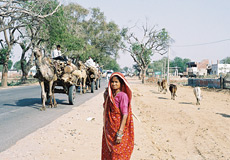 |
 |
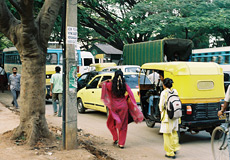 |
| Photos: Gregory Loew | ||
The benefits of accelerators
The head of the Indian Department of Atomic Energy, Anil Kakodkar, has held annual meetings on the ILC and particle physics in recent years. These culminated in the March 2006 meeting of the ILC Global Design Effort (GDE) in Bangalore, a meeting that could turn into a milestone for particle physics in India, particularly for participation in the ILC. Indeed, Indian institutions are on the verge of signing Memoranda of Understanding with US institutions, and RRCAT scientists are already collaborating with CERN physicists on grid-computing systems for the ILC.
During their trip to India, the directors of Fermilab, SLAC, and DESY–Oddone, Jonathan Dorfan, and Albrecht Wagner, respectively–along with GDE director Barry Barish, met with President Kalam. Oddone says, "He [Kalam] was interested in and supportive of the basic science goals of the ILC, but he also wanted to know the possible practical applications for India that would ensue from the ILC accelerator R&D."
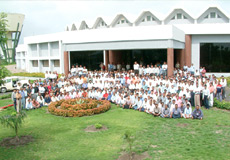 |
| Photo: Monica Bobra |
One of the potential applications arising from ILC involvement could help India develop energy independence. Accelerator technology is needed to take advantage of India's abundant supplies of natural thorium, which are 30% of the world's supply. Nuclear power can be generated using thorium instead of uranium, leaving shorter-lived radioactive byproducts which are unsuitable for weaponization. The process can also burn up conventional, long-lived nuclear waste. However, starting the thorium fuel cycle requires a source of neutrons, something that could only be efficiently provided with a particle-accelerator-based neutron source. Although the ILC itself would not provide the neutrons, working on the technology would give Indian physicist the accelerator skills they need to develop a neutron source.
The quest for accelerator technologies is already helping Indian society in real ways. Like many Indian scientists, S.C. Bapna at RRCAT focuses on work to benefit the country's huge and largely poor population. Some twenty percent of India's food perishes because of limited shelf life. Bapna uses the 10-millimeter beam of a 10 MeV linear accelerator to irradiate a potato, delaying the appearance of sprouts that induce spoilage. "For the first time in the world, we've shown that surface irradiation is good enough to prevent sprouting," he says. Bapna is generalizing his method to apply to many other crops. "I'm very much satisfied that what I am doing is directly useful to mankind," says Bapna.
Indus-II's indigenous origins
The Indus-II synchrotron light source is the most recent large accelerator project to be completed in India, but reflects the Indian homegrown and practical approach to accelerator science.
Twenty-six beamlines branch out from Indus-II's circular pipeline like spokes out of a bicycle wheel's hub, each beamline funneling X-rays down to a minuscule target. And that's where the magic happens, in areas of research ranging from material sciences and chemistry to atomic physics and biology.
For example, it has long been a difficult problem to rid petroleum of air-polluting sulfur. Placing a sample of petroleum in high-energy X-rays from an Indus-II beamline would literally shed intense light on a petroleum sample's structure—and allow scientists to determine exactly how sulfur molecules hide within clusters of hydrocarbons. "You can detect the elemental composition of materials and impurity levels in parts per billion or even better," says RRCAT experimentalist R.V. Nandedkar, one of 400 scientists and engineers involved in designing Indus-II.
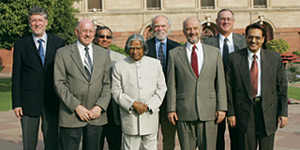 |
| Delegation visiting the President of India before the Bangalore ILC workshop, from left to right: Albrecht Wagner, DESY; Jonathan Dorfan, SLAC; Shekhar Mishra, Fermilab; President of India Abdul Kalam; Barry Barish, ILC GDE Director; Pier Oddone, Fermilab; Bob Kephart, Fermilab and Ram Shivpuri, University of Delhi. |
| Photo courtesy of Pier Oddone |
Most of the Indus-II synchrotron light source was built in India. Only the superconducting radio-frequency cavities, which accelerate the electrons, and the klystrons, which provide the cavities with microwave energy, were manufactured abroad. The "made at home" approach reflects a cultural value of a Ghandi-inspired "indigenousness" to spread knowledge, respect and experience throughout the community. Use of synchrotron light sources is a growth industry around the world, and Indus-II is set to help India develop its domestic research base.
In a May 2005 address to the Indian Council for Scientific and Industrial Research, Prime Minister Singh emphasized an indigenousness of knowledge as the path to the future. "People say that twenty-first century will be the century of knowledge," Singh said. "If this is so, then our foundations on production, distribution, protection, and utilization of knowledge must be strong. Dominance of knowledge economy over the old ‘brick-and-mortar' economy is visible around the world. I am convinced that this is where the Indian advantage lies."
Click here to download the pdf version of this article.






